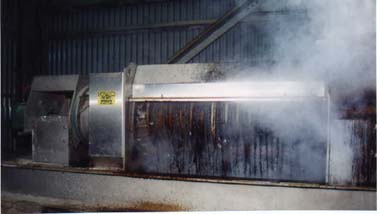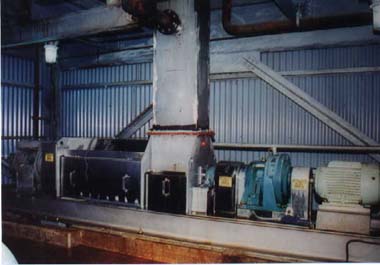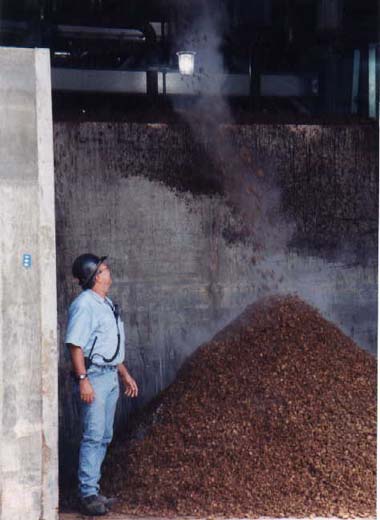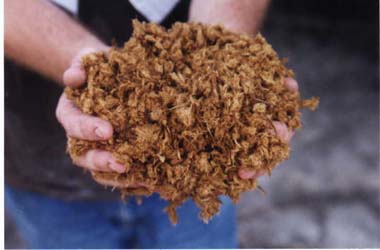Tappi Journal, Vol. 82, No. 2, February 1999
ADVERTISING PAYS!
The project described in this article all started with an ad in The Tappi Journal. The ad was brought to the attention of Joe Lukasik, an engineer at the Atlanta office of Sandwell Inc. At the time Sandwell was working on a fiber recovery project at the James River Naheola Mill in Pennington, Alabama. Through Sandwell, arrangements were made for on- site testing. The success of the trials ultimately led to the four installations described in this article.
An unusual project with many advantages has recently come on stream at the Gilman Paper Mill in St. Marys, Georgia. The installation features a pair of screw presses that are used to dewater quaternary screen rejects. This technology parallels a similar project at Fort James Naheola Mill, with interesting differences.
The Gilman mill, rated at 1,200 tons, has been in service since 1941. It has both hardwood and softwood kraft operations employing thirteen batch digesters. About half of the tonnage goes to bleached and unbleached kraft multiwall specialty products, with the other half going to bleached board, coated and uncoated.
Similarly, the Naheola Mill, rated at 1,100 tons, has both hardwood and softwood kraft operations. About half of the pulp produced in converted on-site to tissue and towels, while the rest is used for packaging board.
At both mills the screw press project was part of a new fiber preparation system that features Thermo Black Clawson pressure screens. At Gilman, the principal benefit of the new system is improved stock quality to the #1 paper machine, while at the same time converting waste materials into useful boiler fuel. In contrast, at Fort James the principal benefit is increased chemical and fiber recovery, while at the same time reducing loading at the wastewater treatment plant.
At Gilman prior to the installation of the new pressure screens and screw presses, rejects from secondary screens were refined and pumped to the blow tank. This was undesirable because it resulted in poor stock quality to one of the paper machines.
In contrast at Fort James, prior to the installation, insufficient quaternary screening was available. Rejects from vibratory (secondary) knotters were accumulated at ground level prior to hauling to landfill, and rejects (mostly shives) from the quaternary pressure screen were diverted to the wastewater treatment plant. This system had poor yield and excessive loss of digester chemicals.
With the new systems, both mills use Vincent screw presses to dewater combined flows of knots, shives, and other rejects.
At Gilman the new system uses a Vincent sidehill screen to thicken the 160 gpm 2.3% consistency flow ahead of each of the screw presses. The screen tailings are funnelled directly into the 12″ presses. At Fort James, in contrast, the flow of quaternary rejects and knots from the knotters flow directly to a 16″ press without benefit of a sidehill screen. Surge flows of up to 400 gpm go to the press.
Both mills use a hot stock screening system. The rejects from the unwashed stock, at 190º F, are what go to the screw press. The press liquor, containing chemicals and some usable fiber, is returned either to the rejects tank supplying the pine side secondary screen or to the chemical and fiber recovery flow.
The horizontal screw press has two screening sections: at the inlet hopper and over the compression stage. An initial knot dewatering application supplied by Vincent Corporation to Fort James Naheola mill had profile bar screens (baskets) with nominal 0.020″ (one half millimeter) slots. To optimize chemical and fiber recovery these were subsequently changed to 3/32″ perforated screens. Based on this experience, the Gilman presses had press screens with 3/32″ perforations from the start.
It was found at Fort James that in normal operation the inlet hopper screen of the press allows free liquor to drop out, which consists of up to 40% of the total pressate flow. In addition an unexpected source of liquor recovery was found to arise from pressing the knots. Testing showed that 20% by weight of knotter rejects is converted into press liquor in a Vincent screw press. It is estimated that this liquid flow amounts to 10% of the total chemical recovery, as well as some of the fiber recovery.
The screw presses were designed specifically for the pulp and paper industry. All contact parts are made of stainless steel (316 at Gilman; 304 at Fort James), and weld applied hardfacing is used on the wear areas of the screw and discharge cone. Heavy duty drive and screw flighting allow the press to operate under conditions of a “hard cook” when material similar to ground wood enters the press. Vibration was minimized in the Gilman presses by specifying that the drive motor be mounted in line with the gearbox. Since this eliminates V-belts from the drive train, a variable frequency drive (VFD) is available. Gasketing compatible with H2S was employed, and all bronze materials (nuts and bushings) were eliminated.
Gasketed covers were supplied with provision for modification for vacuum recovery of vapors. This is in anticipation of future requirements for collection of Total Reduced Sulphur (TRS) emissions.
In passing through the press, the knots are broken into small bundles of fiber. This occurs because the press design is based on an interrupted screw flight with stationary resistor teeth. The agitation and shear caused by these members break down the knots. Some fiber recovery improvement is achieved as a result of this action. It is difficult to spot the difference between the knots and the shives in the press cake.
The press cake moisture can be controlled by adjusting the air pressure actuating the discharge cone (also called a stopper or plug). With this devise press cake moisture in the range of 45% to 55% solids is maintained. In mills where the cake is landfilled, lower cone pressures and higher cake moistures are typical.
At Gilman the press cake is made of elements that previously were refined and recirculated, while at James River they were sent either to landfill or wastewater treatment. With the new installations the rejects are used as boiler fuel at both mills.
Similar installations exist at two other paper mills. At these the press cake is being sold as landscaping mulch and as raw material for an asphalt shingle manufacturing operation. Vincent has supplied screw presses for use on shives to Louisiana-Pacific, Samoa, California and for knots and shives to Buckeye Cellulose, Perry, Florida. The motivating factors at these mills were to facilitate off-site hauling, to avoid landfill problems, and to extend landfill life.
The success of these installations has generated interest in pressing knots and shives. The projects are relatively small and simple. Incremental improvements in pulp making and abatement of environmental pressures are the benefits.
Ross is Chief Engineer, Gilman Paper, 1000 Osborne St., St. Marys, Georgia 31558; and Johnston is Professional Engineer, Vincent Corp., 2810 East 5th Avenue, Tampa, FL 33605.

The flow of hot black liquor being squeezed from the quaternary rejects is seen dramatically when the screw press covers are removed.

One of a pair of Vincent Model VP-12 presses. Tailings from sidehill screens on the floor above drop through the vertical chute into the press.

Press cake drops to a concrete bunker at ground level prior to being transported to the hog fuel boilers.

This press cake typically has 50% solids and has excellent combustion characteristics.
